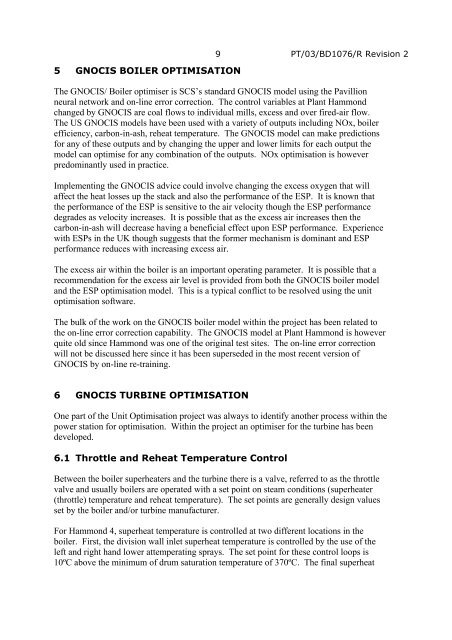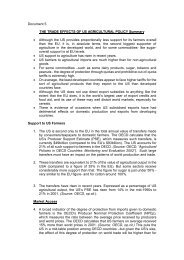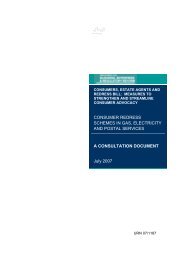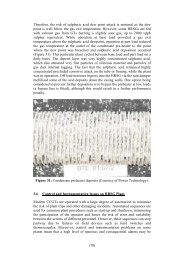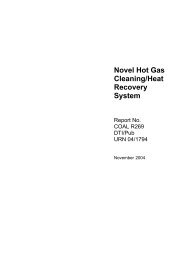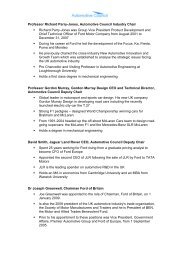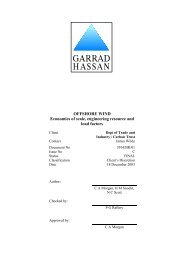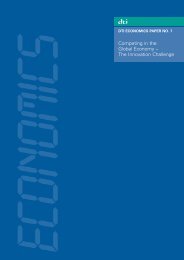Coal Fired Power Plant Operations - DTI Home Page
Coal Fired Power Plant Operations - DTI Home Page
Coal Fired Power Plant Operations - DTI Home Page
Create successful ePaper yourself
Turn your PDF publications into a flip-book with our unique Google optimized e-Paper software.
5 GNOCIS BOILER OPTIMISATION<br />
9 PT/03/BD1076/R Revision 2<br />
The GNOCIS/ Boiler optimiser is SCS’s standard GNOCIS model using the Pavillion<br />
neural network and on-line error correction. The control variables at <strong>Plant</strong> Hammond<br />
changed by GNOCIS are coal flows to individual mills, excess and over fired-air flow.<br />
The US GNOCIS models have been used with a variety of outputs including NOx, boiler<br />
efficiency, carbon-in-ash, reheat temperature. The GNOCIS model can make predictions<br />
for any of these outputs and by changing the upper and lower limits for each output the<br />
model can optimise for any combination of the outputs. NOx optimisation is however<br />
predominantly used in practice.<br />
Implementing the GNOCIS advice could involve changing the excess oxygen that will<br />
affect the heat losses up the stack and also the performance of the ESP. It is known that<br />
the performance of the ESP is sensitive to the air velocity though the ESP performance<br />
degrades as velocity increases. It is possible that as the excess air increases then the<br />
carbon-in-ash will decrease having a beneficial effect upon ESP performance. Experience<br />
with ESPs in the UK though suggests that the former mechanism is dominant and ESP<br />
performance reduces with increasing excess air.<br />
The excess air within the boiler is an important operating parameter. It is possible that a<br />
recommendation for the excess air level is provided from both the GNOCIS boiler model<br />
and the ESP optimisation model. This is a typical conflict to be resolved using the unit<br />
optimisation software.<br />
The bulk of the work on the GNOCIS boiler model within the project has been related to<br />
the on-line error correction capability. The GNOCIS model at <strong>Plant</strong> Hammond is however<br />
quite old since Hammond was one of the original test sites. The on-line error correction<br />
will not be discussed here since it has been superseded in the most recent version of<br />
GNOCIS by on-line re-training.<br />
6 GNOCIS TURBINE OPTIMISATION<br />
One part of the Unit Optimisation project was always to identify another process within the<br />
power station for optimisation. Within the project an optimiser for the turbine has been<br />
developed.<br />
6.1 Throttle and Reheat Temperature Control<br />
Between the boiler superheaters and the turbine there is a valve, referred to as the throttle<br />
valve and usually boilers are operated with a set point on steam conditions (superheater<br />
(throttle) temperature and reheat temperature). The set points are generally design values<br />
set by the boiler and/or turbine manufacturer.<br />
For Hammond 4, superheat temperature is controlled at two different locations in the<br />
boiler. First, the division wall inlet superheat temperature is controlled by the use of the<br />
left and right hand lower attemperating sprays. The set point for these control loops is<br />
10ºC above the minimum of drum saturation temperature of 370ºC. The final superheat


